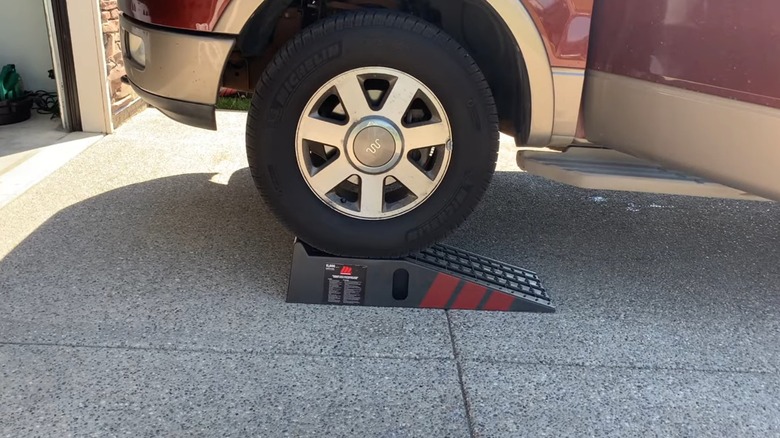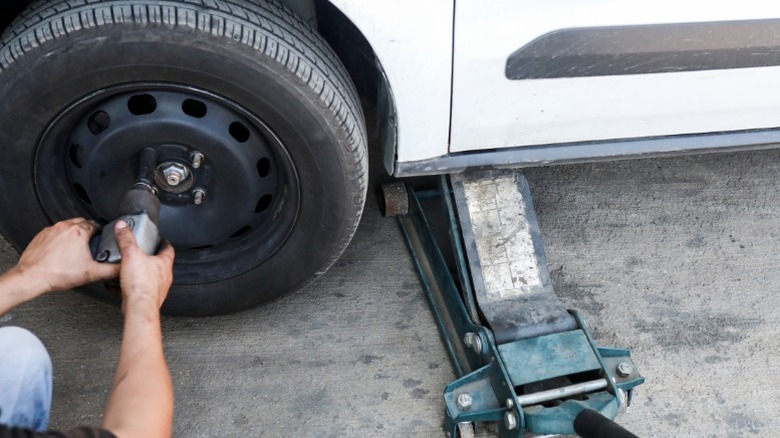Is A Jack Or Ramp Better For An At-Home Oil Change? Here's What You Need To Know
If you're a car owner, you're probably aware of the fact that your vehicle needs routine maintenance to stay in tip-top shape. Performing these tasks is essential for your car's longevity, and the most critical maintenance services are outlined in your owner's manual, along with the intervals at which you need to complete them. When it comes to performing maintenance, you generally have two options: visit a mechanic and pay for the services, or knock them out at home using some basic tools and your DIY skills.
One of the most common forms of care that virtually every vehicle needs is an oil replacement. Oil changes are vital for your engine's health, and they're also one of the easiest DIY auto maintenance jobs that you can complete at home. While the task is simple, even for most beginners, it can be slightly tricky, due to the fact that most passenger vehicles sit too close to the ground to drain the oil. That means you'll have to lift your car slightly if you plan to replace your oil at home. Again, you have a couple of options when it comes to raising your vehicle. Various types of automotive jacks can do the trick, and they're usually pretty simple to use and not too expensive. However, you can also use ramps.
Automotive ramps are designed so that you can drive onto them. That makes them extremely convenient, as it eliminates the need to place multiple jacks beneath the vehicle and then crank them back and forth to lift the car's weight. But ramps aren't ideal for every task, and there are some things you need to know before using them. As a former professional mechanic and lifelong DIYer, I'll explain when you should use one over the other.
Ramps are more convenient if you're only replacing the oil
As mentioned, automotive ramps are extremely convenient for some tasks. Because you drive onto them, using them is as simple as placing them in front of your car's front wheels and then slowly driving forward. The amount of lift you get with ramps varies, depending on the product you buy.
However, most car ramps offer between 6- and 10 inches of vertical lift. It's worth noting that you can generally only lift a single axle at a time using ramps, unless you want to lift the second axle using jacks. That means that ramps aren't the best choice if you need to work underneath the front and rear ends of the vehicle. Finally, ramps are rated for specific weights. It's absolutely critical that, if you choose to use automotive ramps, you buy a set rated for your car's weight.
All that said, if you're only performing an oil change, ramps are an excellent choice. They eliminate the need to deal with jacks and jack stands, which can often be challenging to place properly for novices, and they can substantially decrease the amount of time you spend performing the work. Ramps are also a great option for other services that require you to work underneath one axle without removing the wheels and tires, including things like coolant services and transmission flushes.
Jacks are more versatile for other repair and maintenance jobs
While ramps are convenient, they won't work for every form of maintenance that your car needs. That's because automotive ramps' greatest strength is also their greatest weakness. Driving onto ramps means that you cannot remove the wheels and tires from that axle. For example, if you want to replace your car's front brake pads and rotors, you wouldn't be able to use ramps to lift the vehicle. Instead, you'll have to lift the car from another point, leaving you free to remove the wheels and access the brake assemblies.
The same applies to numerous other tasks which require you to remove the wheels, including things like suspension work, steering system repairs, at-home tire rotations, and even some serpentine belt replacements. That makes jacks more versatile than ramps. Not only can you use them for tasks that require you to remove the wheels, but they're also wonderful options for simple oil changes and other jobs that don't involve the wheels or tires.
Like ramps, though, automotive jacks are also rated for specific weights, meaning it's important to buy a set rated for your car's size. Apart from purchasing jacks with adequate weight capacities, the most important thing to know is how to use them safely. To use a jack, you need to place it beneath a safe lift point on your vehicle. That can translate to different parts of the car, depending on the type of vehicle. Common locations include the frame, pinch welds, control arms, and the rear differential. If you're not sure how to lift your car with jacks, you should reach out to a knowledgeable friend, a professional, or do a thorough amount of research before attempting to raise your vehicle.


